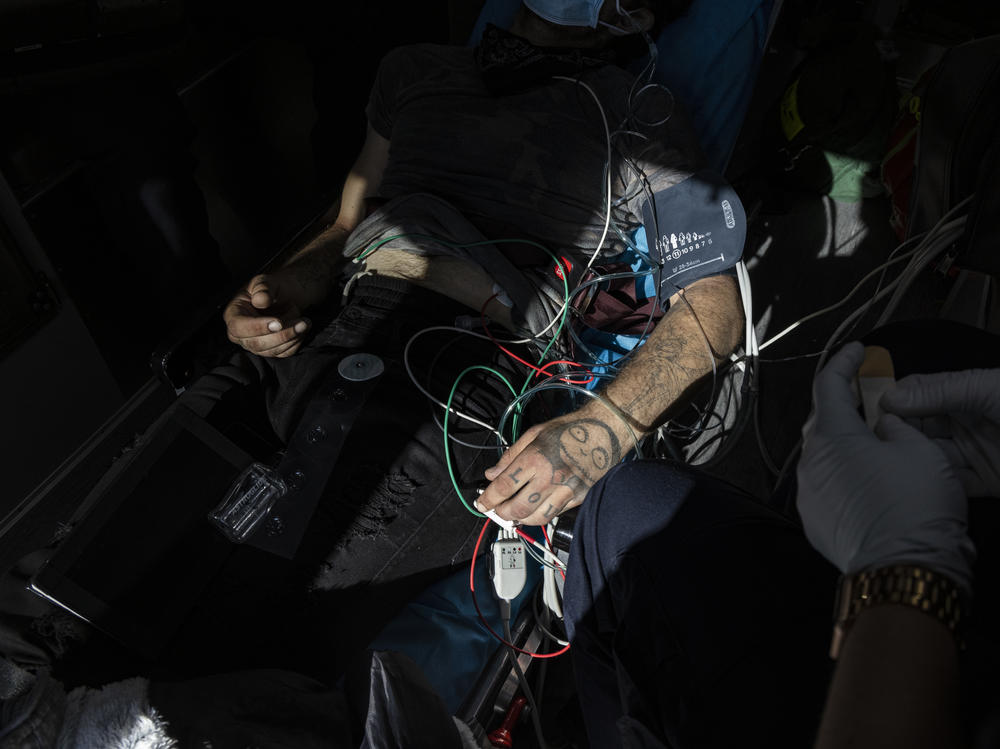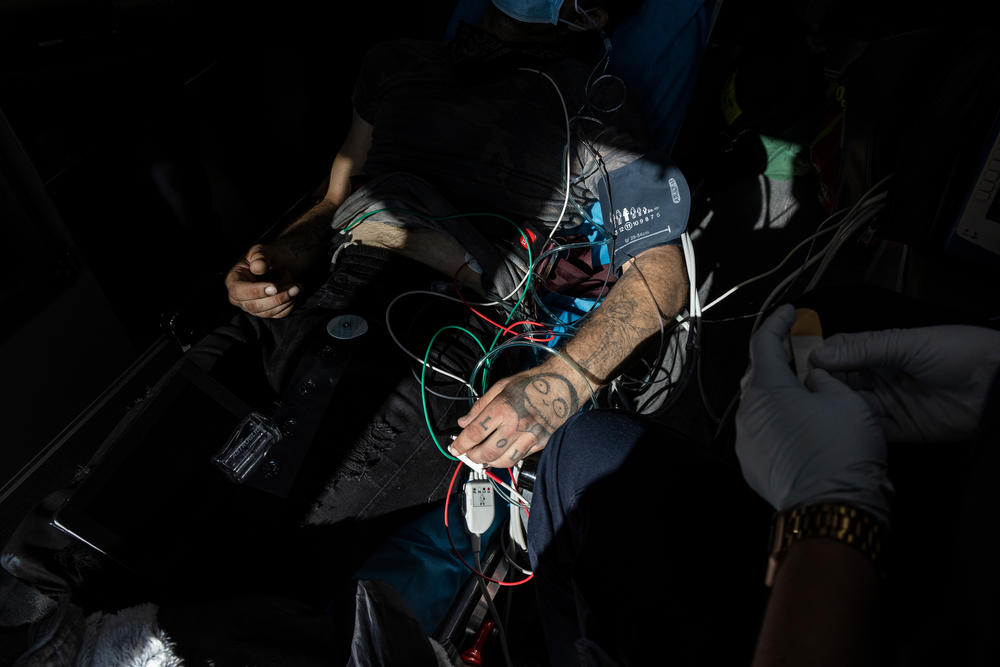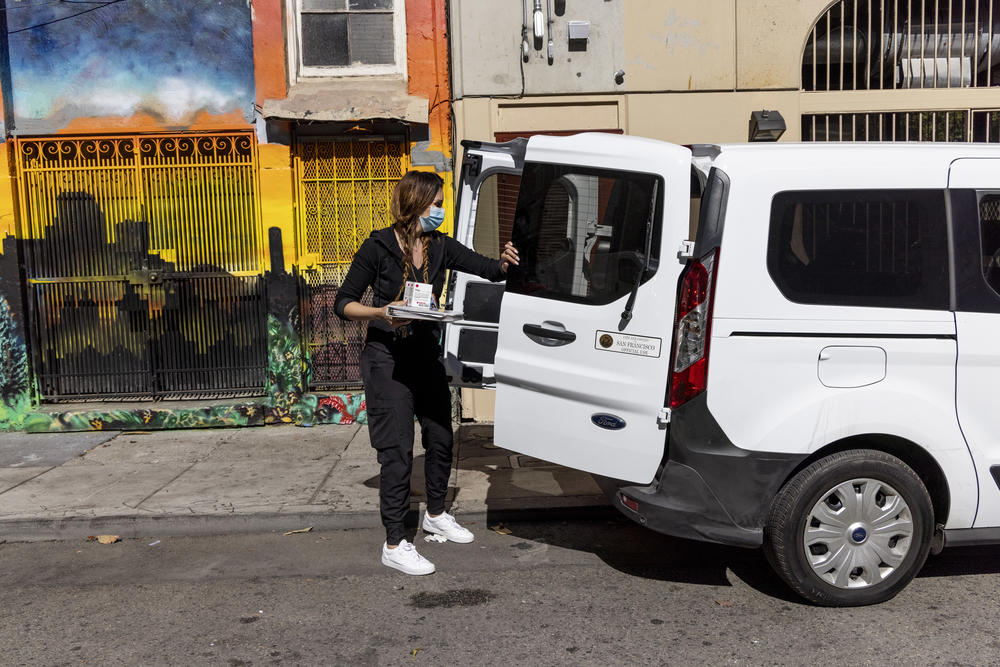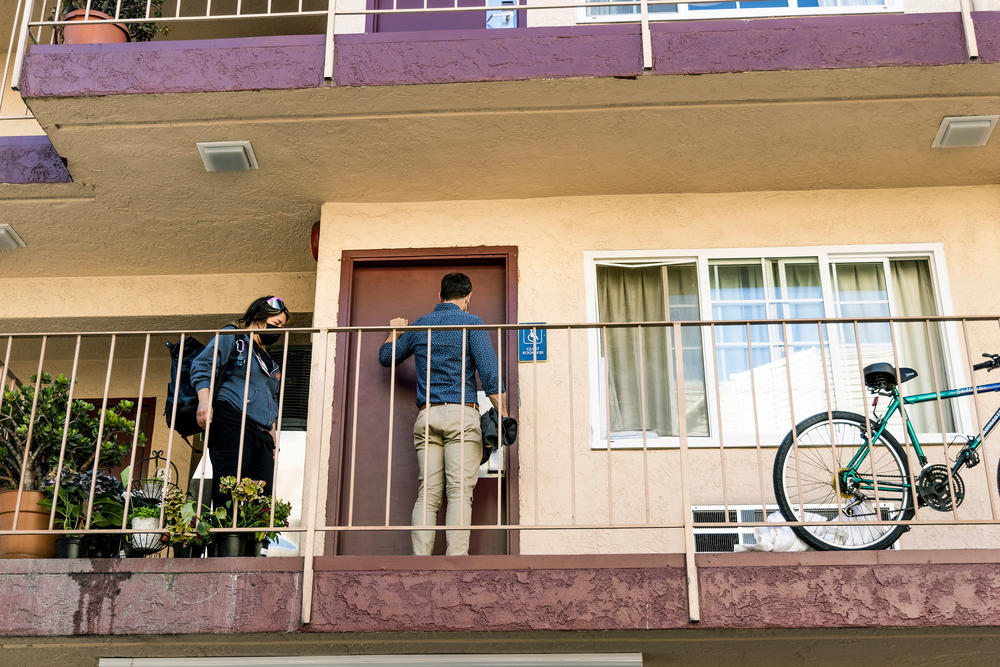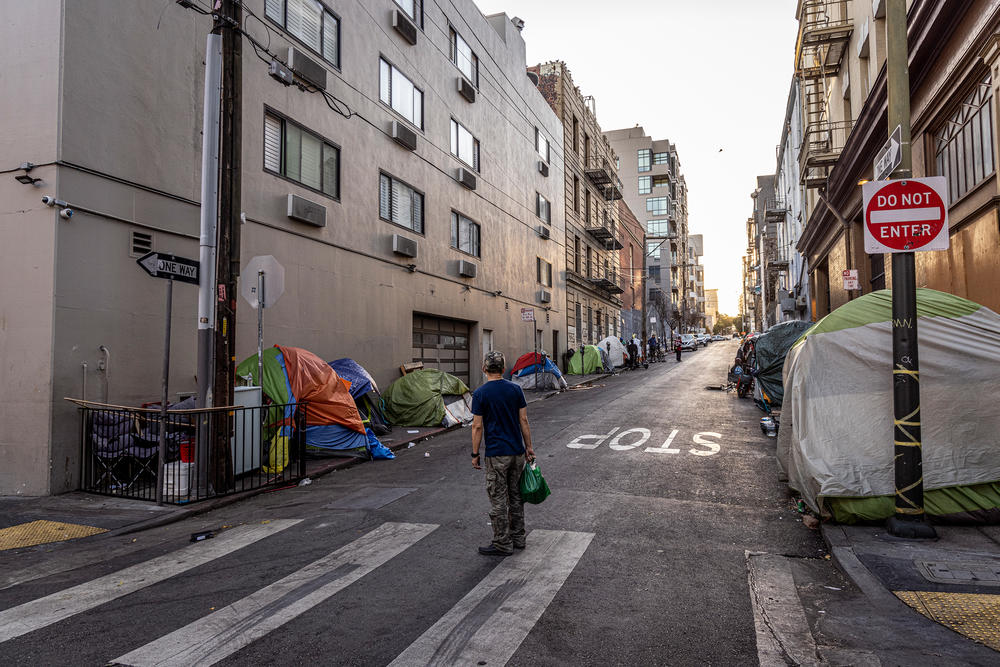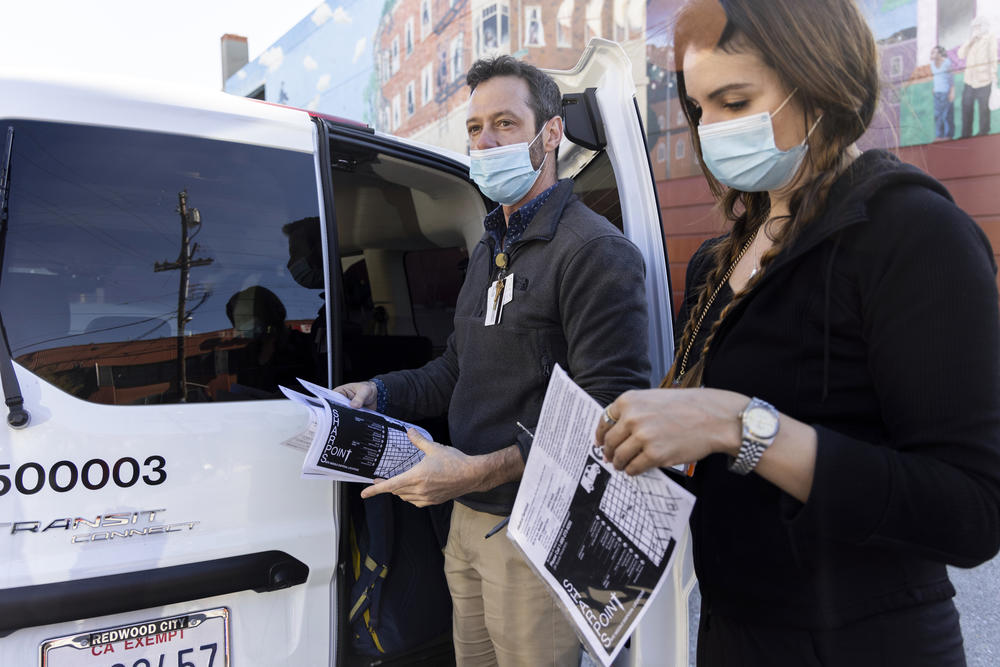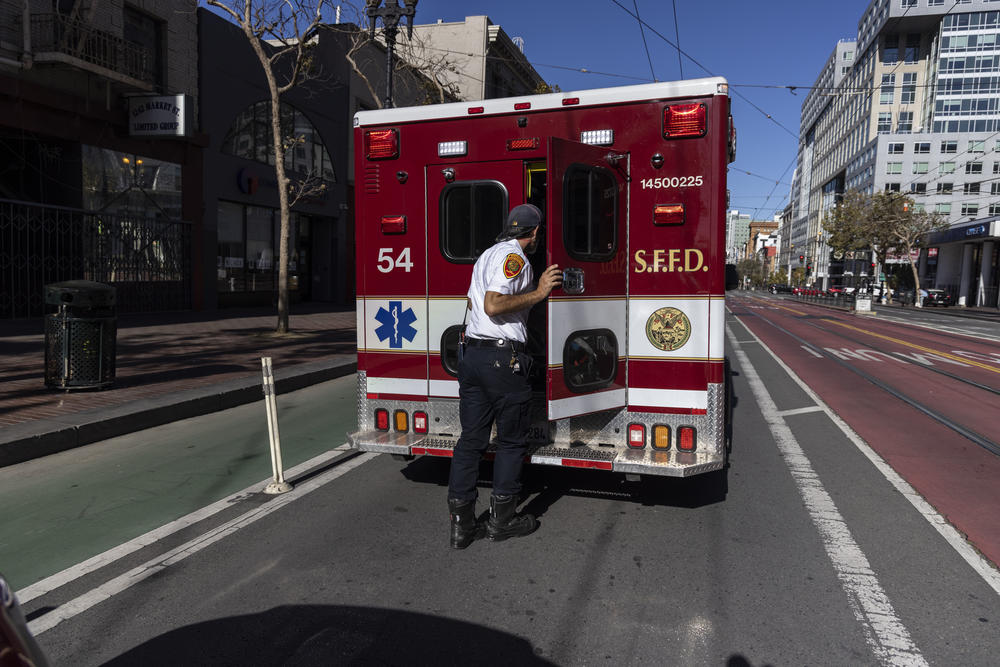Section Branding
Header Content
San Francisco's new rapid response teams race to save lives as ODs dramatically rise
Primary Content
It's a sun-filled, fall day and Nicholas is strapped to an ambulance gurney near 8th and Market streets in downtown San Francisco, dazed and barely conscious. Plastic IV tubes snake around his left hand where L-O-V-E is tattooed just below his knuckles.
"Nicholas, try to wake up a little bit for me, come on," paramedic Paula Fartash coaxes, as she unsuccessfully tries to rouse him from his drug-induced stupor.
Nicholas (we're not using his last name because of the stigma of addiction) tells Fartash that when he started getting high in nearby U.N. Plaza park, he assumed he was smoking his drug of choice.
"This gentleman thought that he was doing meth," the veteran San Francisco Fire Department paramedic says. "And turned out he was actually doing fentanyl as well," the synthetic opioid many times more powerful than heroin. "So he walked over to someone and they gave him some Narcan."
That's the brand name for naloxone, the emergency nasal spray drug used to try to reverse an otherwise potentially fatal overdose. That someone who administered life-saving antidote was a nearby volunteer and street cleaner carrying Narcan. It's part of a city-supported program.
San Francisco has among the highest per capita drug overdose death rates of any city in the U.S.
Faced with a stunning rise in drug overdose deaths the last few years, the vast majority tied to fentanyl, San Francisco has launched mobile teams made up of paramedics and nurses. The new Street Overdose Response Teams (SORT), a collaboration between the city's health and fire departments, aim to deliver a broad range of support and care directly following an overdose.
"Fentanyl is a game-changer," Dr. Hillary Kunins, the city's director of behavioral and mental health services, says of the opioid that's 80 to 100 times stronger than morphine. "It requires a new way of thinking and resourcing." It also, she says, "requires people to learn to work across disciplines and sometimes across organizations."
Dr. Kunins previously led New York City's response to its overdose and substance abuse crisis. She concedes they aren't sure what combination of tools, ultimately, will work best here to not only reduce fentanyl and other drug-related deaths but also boost treatment success rates.
So the street overdose pilot project is part of a broad and ambitious strategy of interventions across city agencies.
"There is no single approach that's going to solve this complex problem," Kunins says. "What's exciting and important about the work is that it is really part of a movement across the country to rethink how we address people who are at risk of overdose, who have ongoing other challenges: mental health, housing, food. And we must do this work to scale."
Fentanyl forced city officials to change how they approached harm reduction
Capt. Michael Mason, a paramedic, is the fire department's point person on the new program. As he races to the call for Nicholas' overdose, he's simultaneously coordinating with other paramedics.
"So starting directly at the scene of this overdose, we can start trying to direct this guy's care in the best direction possible," Mason says.
That direct engagement could include helping to find a shelter bed, reaching out to friends or a doctor, helping with food or, most importantly, seeing if a person wants to start treatment with buprenorphine or suboxone, a medicated-assisted therapy for opioid dependence.
"Get this individual suboxone, stabilize him at the [emergency department], by that afternoon they can be in a treatment program," Mason says, "All in the context of a 911 incident."
For many years San Francisco has championed a harm reduction public health approach to lowering drug deaths and injury. The city, known for its relative tolerance of illicit drug use, was a pioneer of clean syringe access, distribution of life-saving naloxone kits, as well as boosting access to the treatment drugs methadone and buprenorphine.
But when fentanyl hit hard here starting a few years ago, the overdose crisis spiraled and the city was forced to rethink its approach. Free Narcan and syringes weren't enough.
"If fentanyl is in the drugs that you're using, your risk of overdose triples," Capt. Mason says, adding that the drug is now tainting most every street narcotic here: Meth, cocaine, heroin and fake opioid pills.
The new street response teams bring the clinic to the patients
Pandemic isolation and lockdowns — people using alone with no one to administer life-saving Narcan — only partially explain the historic rise in overdose deaths here.
The drug death rate, in fact, had been trending higher well before that, city medical examiner data show. In mid-2018 the numbers began to skyrocket, reaching 441 deaths in 2019. And in 2020, a whopping 712 people fatally overdosed, more than double the number of people here who died from COVID-19 during that same period.
The vast majority of those deaths – almost three-quarters –involved fentanyl.
The death toll would have been even higher if not for the wide availability of Narcan here. Well over 3,000 people reported using Narcan in the city in 2020, a self-reported figure. Officials say the real figure is probably far higher.
But health and fire department officials here, Mason says, noticed something else important: almost half of all who died of an overdose were treated or revived by a paramedic crew in the days or weeks before their death, a big signal they were headed for repeat trouble.
"Surviving a nonfatal overdose is one of the best predictors of future mortality. Anyone who survives a non-fatal overdose is a huge red flag for us, and that is what this program is about," he says.
A key goal is trying to bring the clinic to the patients: rapid, face-to-face follow-up outreach on the street.
"We go out, we look for them, we say, 'Hey, let's talk about yesterday,'" says city health department nurse practitioner Kevin Lagor, as he drives through the Tenderloin neighborhood, where many of his clients live. He's a program lead with SORT's outreach arm.
The goal is to reach back out within 24 to 72 hours of an overdose to try to assist the person with everything from housing to treatment.
"That could be providing medical care to address their mental illness. Maybe they're out of their meds, or maybe they want to start something to address their substance use disorder," he says. "Just kind of, basically, meeting them where they are and seeing what they need and how we can help them."
But to meet them where they are, the nurse teams first have to find them.
It's a huge challenge. Many of them are homeless, living in tents on the street or in and out of shelters.
The overdose and substance abuse crisis is directly linked to the city's epic struggles with homelessness and related challenges including mental illness. Almost 30% of all overdose deaths here are among the unhoused or people "with no fixed address." SORT collaborates closely with the city's other programs, including street medicine and new mental health and homeless street crisis response units.
City data show that men were almost four-times more likely to die of an accidental overdose than women. And the homeless, older San Franciscans and minority communities were disproportionately affected by the death rate. Almost quarter of all overdose deaths are among Black San Franciscans who make up just under 6% of the city's population.
More than 40% of all overdose deaths in the last year have been concentrated in two neighborhoods: the South of Market area and the Tenderloin, according to data from the city and county chief medical examiner's office. Those areas make up just 7% of the city's population.
While drug deaths hit every sector of society, many who overdosed were found in city-funded hotel rooms for the homeless and in low-income apartment buildings.
"We have to remember that this is a social crisis at the intersection, particularly in San Francisco, of a housing crisis, of a mental health crisis, of people living at the margins of society," says Dr. Dan Ciccarone, a professor and researcher at University of California, San Francisco.
Open air drug use and dealing in the Tenderloin, an area long challenged by poverty, homelessness and addiction crises, has only worsened during the pandemic. It's common, day or night, to see people smoking or shooting up opioids or nodding out from drug use.
One 32-year-old man named Neil says he's been homeless and living on the streets, mainly in the Tenderloin, for three years now. We're not using his last name because of the stigma of addiction.
He says he uses fentanyl "to take the edge off" off of his depression and chronic stomach pain. He occasionally sells drugs, he says, to get money to support his habit. He soon crushes a small amount of fentanyl into a piece of tinfoil and begins to smoke the drug.
Follow-up work by nurses is full of challenges
On a recent day, nurse Lagor has half a dozen clients listed on his clipboard. He can't find a single person.
"So we'll just kind of keep following up with the staff at the shelter," he says in the lobby of one facility, having been unable to find a client.
The same happens at a makeshift tent encampment behind a local Best Buy.
Outside another shelter, Lagor and his team strike out again trying to find a young man they thought they were making progress with. They'd recently written him a prescription for a supply of buprenorphine.
"He hasn't been here in a couple of days," Lagor says, disappointed.
"It is a bad sign. Sometimes folks disappear for a couple days and then resurface," he says. "Then they disappear, or it just falls apart."
And when it all falls apart, it can hit Lagor and the rest of his team hard.
"It's a lot of death and they're not strangers. You know, we've had a couple of deaths this week and we've, we shed tears together," Lagor says. "It's hard not to care about someone when you're really trying to help them."
Addiction and public health experts say these mobile, non-police teams mark a much-needed pivot for the city.
"It's bold and it's innovative. I like it," says Dr. Ciccarone, a professor of medicine at UC San Francisco and a leading expert on drug use, drug users and heroin. "We need to bring in some innovations here because fentanyl is a wild card and it has caught us all by surprise. That's what we need to do in a crisis situation: Think creatively."
But Dr. Ciccarone cautions that the ravages of fentanyl and its complex stew of related challenges mean the city needs to scale-up this new street overdose response program and continue to try to break down obstacles to treatment that include bureaucratic silos, turf battles and funding woes.
"It's definitely not enough," he says. "We have to make sure that harm reduction is adequately funded, that our mental health system, our substance treatment system, our housing systems are adequately funded."
So far, just two months since the program's launch, 10% of those encountered by the SORT teams who've overdosed are now getting medicated assisted treatment for opioid use disorder. That includes buprenorphine or suboxone in collaboration with city's street medicine nurses.
"I'm proud of that number," Capt. Mason says, "and I very much look forward to increasing that."
To get that number even higher, the fire department has applied to the state EMS agency to allow paramedics to more easily administer and prescribe those treatment drugs directly in the field.
Despite a recent slight drop in monthly fatalities the city looks to end 2021 with more than 700 overdose deaths for the second year in a row. Unfortunately, Dr. Kunins, the city's director of behavioral health services, says San Francisco is "on track to continue this really tragic loss of life."
Paramedics on the team look for small victories
Back on the street, another call comes in from the 911 dispatcher for a possible overdose. A middle-aged woman has been found slumped over in a McDonald's bathroom across town in the Fillmore district.
Capt. Mason's occasional staccato siren squawks aren't working on a handful of indifferent drivers and pedestrians in heavy rush-hour traffic. So he hits his fire truck's lights sirens full bore.
When they arrive, the woman tells the paramedics she has relapsed after several months of sobriety.
The heroin she bought, Mason says, was likely laced with fentanyl. Narcan saved her.
Inside the ambulance, Mason says the woman handed paramedics a crumpled, greasy brown fast-food bag and asks that they get rid of it.
"There were some clean syringes in there and what appeared to be small bags of heroin."
Mason finds out she was already part of a medicated-assisted treatment program using suboxone. He says she told them that she wants to get sober again.
"She was feeling extreme shame from experiencing a relapse," he says. "Substance use disorder impacts millions of Americans. There's no shame in having a relapse."
He hopes she restarts her suboxone treatment quickly.
"As for today," Mason says, "and as for surrendering those items and requesting they be disposed of, my hat's off to her."
The paramedics and nurses involved in this pilot project are dedicated to this difficult work. But all say working across multiple city agencies, treatment centers, health providers and non-profits can be exhausting.
"It's complicated," Mason says with a sigh, "it takes work from dozens of folks in a single encounter."
How does he handle the strain of 12-hour shifts filled racing from overdose to overdose, including to some who seemingly don't want help and others who don't survive?
"For my own mental health, I have to kind of remain an optimistic warrior," he says, driving his fire department pick-up through rush hour traffic. "There's a quote in the Talmud that says, I won't get it exactly right, but essentially says, "You don't have to end this work, but you do have to start it.'"
And the woman who overdosed in the McDonald's bathroom who wants help again? It's a small victory.
Maybe.
It's a start.
Copyright 2021 NPR. To see more, visit https://www.npr.org.
